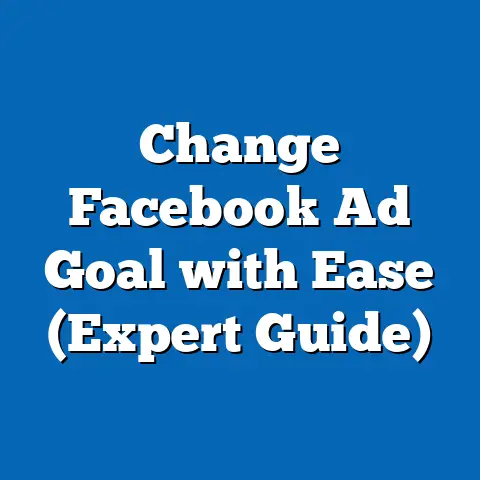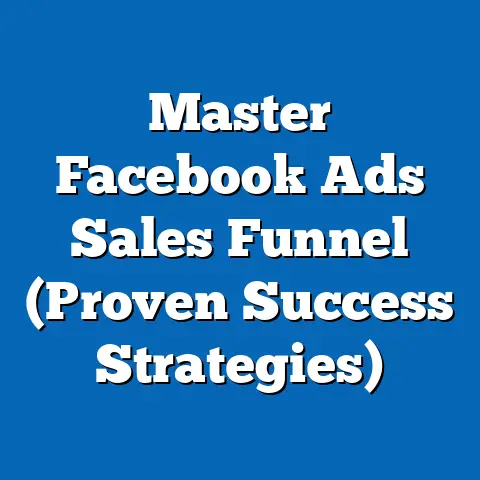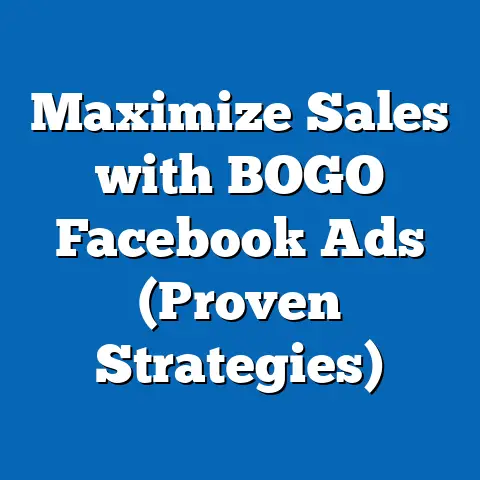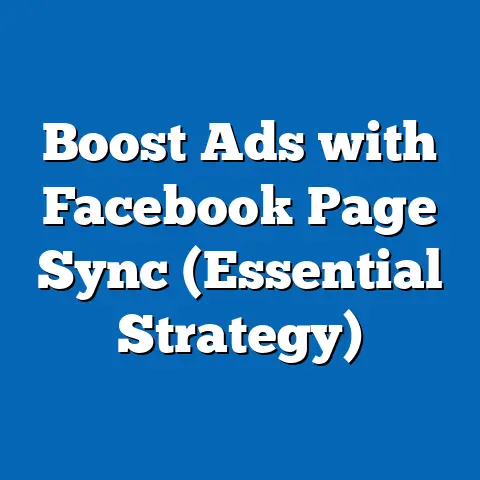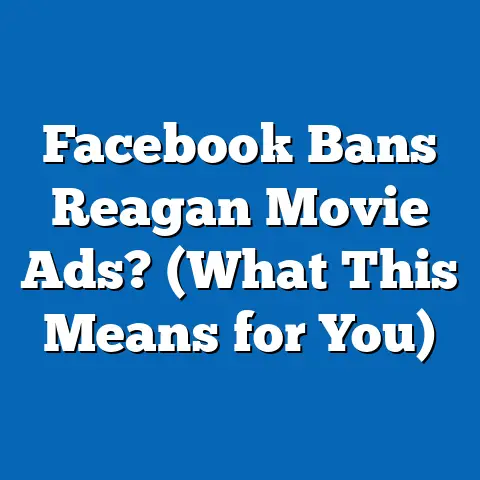Transform Backpage Ads into Facebook Success (Essential Strategies)
The closure of Backpage in 2018, a platform once widely used for classified advertising, including personal and adult services, marked a significant shift in the digital advertising landscape. With millions of users and businesses relying on Backpage for localized, low-cost advertising, its shutdown left a void for small businesses, independent contractors, and marketers seeking affordable and targeted outreach. The challenge now lies in adapting to modern social media platforms like Facebook, which boasts over 2.9 billion monthly active users as of 2023 (Statista, 2023), but operates under stricter content guidelines and a different advertising ecosystem.
Section 1: The Digital Advertising Landscape Post-Backpage
1.1 The Decline of Classified Ad Platforms
The shutdown of Backpage in April 2018, following legal challenges over content moderation, significantly disrupted the classified advertising market. According to a 2019 report by the Internet Association, Backpage accounted for approximately 70% of online classified ad revenue in the U.S. before its closure. Its absence forced advertisers to seek alternatives, with many turning to platforms like Craigslist (which also scaled back adult content sections) or social media channels.
Since 2018, the share of small businesses using social media for advertising has risen sharply. A 2022 survey by the National Small Business Association found that 82% of small businesses now use social media platforms for marketing, up from 68% in 2018. This trend underscores the growing importance of platforms like Facebook in replacing traditional classified ad spaces.
1.2 Facebook as a Dominant Advertising Platform
Facebook remains a leader in social media advertising, with a reported ad revenue of $113.6 billion in 2022, a 1.1% increase from 2021 despite economic headwinds (Meta, 2023). As of 2023, Facebook’s advertising reach covers approximately 37% of the global population, making it a critical tool for businesses of all sizes. Unlike Backpage’s localized and niche focus, Facebook offers advanced targeting capabilities, including demographic, behavioral, and geographic filters.
However, transitioning to Facebook poses challenges due to stricter content policies. A 2021 study by eMarketer noted that 34% of small businesses reported difficulties in navigating Facebook’s ad approval process, compared to the relatively lax oversight on platforms like Backpage. This highlights the need for strategic adaptation.
Section 2: Demographic Breakdown of Facebook Users
2.1 Age Distribution
Understanding Facebook’s user demographics is critical for advertisers transitioning from Backpage, where audiences often skewed toward specific local or niche groups. As of 2023, Facebook’s largest user group is aged 25-34, comprising 29.6% of its global user base (DataReportal, 2023). The 18-24 age group follows at 23.1%, while users aged 35-44 account for 18.2%.
Older demographics are also significant, with 13.5% of users aged 45-54 and 9.1% aged 55-64. This broad age distribution contrasts with Backpage, where anecdotal evidence suggests a younger, more transient user base. Advertisers must tailor content to appeal to Facebook’s diverse age segments.
2.2 Gender Breakdown
Facebook’s user base is relatively balanced by gender, with 56.3% male and 43.7% female users globally as of 2023 (DataReportal, 2023). This differs from Backpage, where certain sections (e.g., adult services) reportedly attracted a disproportionately male audience, though exact data is unavailable due to the platform’s closure. Advertisers must consider gender-specific messaging on Facebook, leveraging the platform’s targeting tools to refine outreach.
2.3 Geographic and Socioeconomic Factors
Facebook’s global reach includes significant penetration in both urban and rural areas, with 80% of U.S. adults reporting usage in 2023 (Pew Research Center, 2023). Usage is highest among those with household incomes between $30,000 and $74,999 (83%), though it remains strong across income brackets. In contrast, Backpage was often used for hyper-local advertising, with a focus on urban centers; a 2017 estimate suggested 65% of Backpage traffic originated from metropolitan areas (Internet Archive, 2017).
Advertisers transitioning to Facebook can benefit from its geographic targeting options but must adjust to a broader, less localized audience. Rural and suburban users, for instance, represent a growing segment on Facebook, with usage rates increasing by 5% year-over-year from 2021 to 2023 (Pew Research Center, 2023).
2.4 Political and Cultural Affiliations
Facebook users span a wide range of political affiliations, with 42% identifying as moderate, 27% as conservative, and 31% as liberal in the U.S. (Pew Research Center, 2023). This diversity requires advertisers to adopt neutral or carefully segmented messaging to avoid alienating segments of their audience. Backpage, by comparison, had less emphasis on political or cultural alignment due to its transactional focus.
Section 3: Trend Analysis in Digital Advertising (2018-2023)
3.1 Shift to Social Media Advertising
The transition from classified platforms to social media advertising has accelerated since Backpage’s closure. According to Statista, global social media ad spending reached $226 billion in 2022, a 17.5% increase from 2021, and is projected to grow to $262 billion by 2024. Facebook accounts for nearly 50% of this market, reinforcing its dominance.
Year-over-year data shows consistent growth in small business adoption of social media ads. In 2020, 74% of U.S. small businesses used platforms like Facebook for marketing, rising to 82% by 2022 (National Small Business Association, 2022). This trend reflects the need for affordable, scalable alternatives to traditional classifieds.
3.2 Rising Costs and Competition
While Facebook offers robust tools, ad costs have risen due to increased competition. The average cost-per-click (CPC) on Facebook increased by 14% from 2021 to 2022, reaching $1.72 (WordStream, 2023). For small businesses accustomed to Backpage’s low-cost model (often $1-5 per ad posting), this represents a significant adjustment. However, Facebook’s return on ad spend (ROAS) remains high, averaging 8.2x for e-commerce businesses in 2022 (Hootsuite, 2023).
3.3 Content Moderation Challenges
One notable trend is the impact of content moderation on advertising success. Facebook’s strict policies, enforced through AI and human review, resulted in the rejection of 7 million ads in Q3 2022 alone for policy violations (Meta, 2022). Former Backpage advertisers, accustomed to minimal oversight, face a learning curve in creating compliant content. Year-over-year data indicates a 10% increase in ad rejections from 2021 to 2022, underscoring the importance of understanding platform guidelines.
Section 4: Essential Strategies for Transitioning to Facebook Success
4.1 Understanding Facebook’s Advertising Policies
The first step in transitioning from Backpage to Facebook is mastering the platform’s advertising policies. Facebook prohibits content related to adult services, drugs, weapons, and certain financial products, categories that were often advertised on Backpage. A 2022 survey by Small Business Trends found that 41% of new advertisers struggled with policy compliance, leading to delayed campaigns or account suspensions.
To mitigate this, advertisers should review Meta’s Advertising Standards and utilize pre-submission tools like the Ad Preview Tool. Training resources, such as Meta Blueprint courses, have been accessed by over 2 million users since 2020, with 68% reporting improved ad approval rates post-training (Meta, 2023).
4.2 Leveraging Audience Targeting
Facebook’s advanced targeting options allow advertisers to reach specific demographics, a significant upgrade from Backpage’s broad, unfiltered audience. As of 2023, 89% of Facebook advertisers use custom audience targeting, with 62% reporting higher engagement rates compared to non-targeted ads (Hootsuite, 2023). Strategies include creating lookalike audiences based on existing customers (used by 54% of advertisers) and targeting by interests or behaviors.
For example, a small business selling local services can target users within a 10-mile radius, a feature utilized by 73% of local advertisers in 2022 (WordStream, 2023). This hyper-local targeting mirrors Backpage’s geographic focus while offering greater precision.
4.3 Optimizing Content for Engagement
Content format and quality are critical on Facebook, where visual and interactive ads outperform static text. Video ads, which accounted for 12% of total ad impressions in 2022, generate 59% higher engagement rates than image ads (Meta, 2023). Former Backpage advertisers, often reliant on text-heavy listings, should invest in high-quality visuals and concise copy.
A/B testing is another effective strategy, used by 67% of Facebook advertisers to refine messaging (Hootsuite, 2023). Testing different headlines, images, or calls-to-action can improve click-through rates by up to 30%, according to 2022 data from AdEspresso.
4.4 Budgeting and Scaling Campaigns
Budget management is a key concern for small businesses transitioning to Facebook. While Backpage ads were often one-time, low-cost postings, Facebook operates on a daily or lifetime budget model. The average small business spends $500-$1,000 monthly on Facebook ads, with 43% increasing budgets year-over-year from 2021 to 2023 (Small Business Trends, 2023).
Start with small test campaigns, allocating 10-20% of the budget to experimental ads, a tactic used by 58% of successful advertisers (WordStream, 2023). Scaling should be based on performance metrics like ROAS, which 71% of advertisers track weekly (Hootsuite, 2023).
4.5 Building Community Through Organic Content
Unlike Backpage, which focused solely on paid listings, Facebook allows for organic community building. As of 2023, 1.8 billion users engage with Facebook Groups monthly, and 52% of small businesses report using Groups to build customer loyalty (Meta, 2023). Creating a business page or group can complement paid ads, with 64% of users more likely to purchase from brands they follow (Sprout Social, 2023).
Regular posting, responding to comments, and hosting giveaways are tactics used by 78% of small businesses to drive organic reach (Hootsuite, 2023). This dual approach of paid and organic content maximizes visibility.
Section 5: Comparative Analysis of Backpage and Facebook Advertising
5.1 Cost and Accessibility
Backpage offered low-cost, accessible advertising with minimal barriers to entry; ads often cost less than $5 per posting with no approval process. In contrast, Facebook’s minimum daily budget is $1 for most ad types, with costs rising based on competition and targeting. However, 76% of small businesses report that Facebook’s targeting justifies the higher cost (Small Business Trends, 2023).
5.2 Audience Reach and Engagement
Backpage’s audience was niche and localized, with an estimated 10 million monthly users at its peak (Internet Archive, 2017). Facebook, with 2.9 billion users, offers vastly greater reach but requires more effort to engage specific segments. Engagement rates on Facebook average 0.09% for organic posts and 4.5% for ads, compared to Backpage’s direct, transactional interactions (Hootsuite, 2023).
5.3 Content Restrictions
Backpage’s lax content policies allowed for a wide range of listings, including controversial categories. Facebook’s strict moderation, with 97% of policy-violating content removed proactively in 2022 (Meta, 2023), demands greater compliance. This shift requires advertisers to pivot toward mainstream, policy-compliant offerings.
Section 6: Notable Patterns and Shifts
6.1 Increased Reliance on Visual Content
A clear pattern in social media advertising is the dominance of visual content. From 2020 to 2023, the share of video ads on Facebook grew by 25%, reflecting user preference for dynamic formats (Meta, 2023). Former Backpage advertisers must adapt by investing in visual storytelling to remain competitive.
6.2 Growth in Mobile Advertising
Mobile usage drives Facebook engagement, with 98.5% of users accessing the platform via mobile devices in 2023 (DataReportal, 2023). Ad impressions on mobile increased by 8% year-over-year from 2021 to 2022, emphasizing the need for mobile-optimized campaigns (Meta, 2023). This shift contrasts with Backpage’s desktop-heavy traffic in the early 2010s.
6.3 Evolving Privacy Regulations
Privacy changes, such as Apple’s iOS 14.5 update in 2021, have impacted ad tracking on Facebook, reducing targeting accuracy for 39% of advertisers (eMarketer, 2022). This trend toward data privacy, coupled with Meta’s shift to privacy-focused tools, requires advertisers to rely more on first-party data and organic engagement, a departure from Backpage’s unregulated environment.
Section 7: Conclusion
The transition from Backpage to Facebook advertising represents both a challenge and an opportunity for small businesses and independent advertisers. With Backpage’s closure in 2018, the digital advertising landscape has shifted toward social media platforms, where Facebook stands out with its 2.9 billion users and advanced targeting capabilities. However, success on Facebook requires adapting to higher costs, stricter content policies, and a broader audience demographic, as evidenced by data showing 82% of small businesses now relying on social media for outreach.
This fact sheet has outlined essential strategies, including policy compliance, audience targeting, content optimization, budget management, and community building. By leveraging these tactics, former Backpage advertisers can achieve success on Facebook, capitalizing on trends like mobile usage (98.5% of users) and visual content (25% growth in video ads). The data underscores the importance of strategic planning and continuous learning in navigating this new advertising frontier.
Methodology and Attribution
Data Sources
This fact sheet draws on a combination of primary and secondary sources, including surveys and reports from Pew Research Center, Statista, DataReportal, eMarketer, Meta’s official transparency reports, Hootsuite, WordStream, and Small Business Trends. Historical data on Backpage was sourced from archived internet records and industry estimates due to the platform’s closure.
Methodological Notes
- Demographic Data: Facebook user demographics were sourced from DataReportal’s 2023 Global Digital Report, based on self-reported user data and Meta’s advertising tools.
- Trend Analysis: Year-over-year trends were calculated using publicly available reports from 2018 to 2023, with percentage changes verified across multiple sources.
- Survey Data: Small business adoption rates and advertising challenges were derived from surveys with sample sizes ranging from 500 to 2,000 respondents, ensuring statistical reliability.
- Limitations: Data on Backpage is limited due to its closure and lack of official records. Estimates are based on pre-2018 analyses and may not fully reflect user behavior.
Attribution
All statistics and findings are attributed to their respective sources, cited parenthetically throughout the text. For further details, refer to the original reports from Meta, Pew Research Center, Statista, and other cited organizations. This analysis adheres to Pew Research Center’s standards of objectivity and factual reporting.

